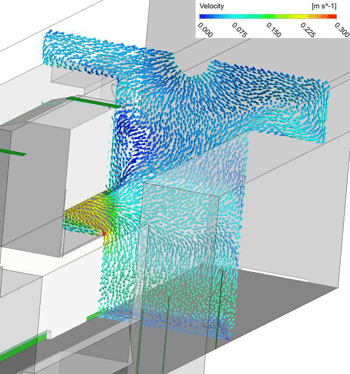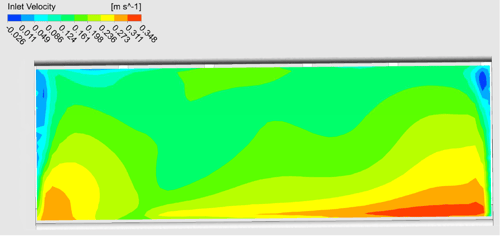One of the most important security components inside a laboratory is the fume cupboard. It helps to avoid risks deriving from handling hazardous substances. Therefore, laboratory staff should be advised of various rules of action – each of them for protecting the own health. However, what if there are unidentified air flow phenomena inside laboratories causing unexpected exhaust flow from a fume cupboard, which has previously been tested under ideal conditions and is carefully operated according to manufacturer's instruction?
For ensuring the functioning of fume cupboards the European standard EN 14175 addresses both testing of fume cupboards under controlled conditions (type testing) and monitoring of fume cupboards installed inside laboratories (on-site testing).
Standards and Limits
This standard specifies that the face velocities in the sash openings have to be detected. Furthermore, it describes how to measure the retention capacity of fume cupboards. The limits allowed for passing such type test are not given by the standard but by national authorities, for example by the BG Chemie in Germany. However, these limits might vary between different countries.
These type tests are performed in special testing rooms and under controlled test conditions in order to have a comparable situation for testing the quality of different types of fume cupboards. The results of these tests set the minimum volume of exhaust air which ensures that the respective fume cupboard will also pass an on-site-test. In many cases this volume of exhaust air is used as a basis for designing the ventilation system of the laboratory in which the fume cupboard shall be located.
In the past too little attention has been put to the fact that it is nearly impossible to transfer ideal conditions inside a test room for working conditions inside a real laboratory.
An operator of a laboratory is obliged to inspect newly installed or existing fume cupboards directly at the installation site. This on-site testing described by the European standard EN 14175 includes the measurement of the face velocity in the sash openings and thereby controls the exhaust airflow of the fume cupboard. Nowadays also the retention capacity of a fume cupboard is tested in order to ensure that the actual function of the fume cupboards is correct.
Case Study:
Reconstruction of a Laboratory
Referring to one recent project the following explanation shows how even small variations within air flow inside a laboratory can cause rather unexpected problems:
During a broad renovation procedure several laboratories of a big pharmaceutical manufacturer had been equipped with new fume cupboards. After this installation Tintschl BioEnergie und Strömungstechnik AG was asked to examine these new fume cupboards. Apart from measuring the face velocities and the exhaust airflow of all fume cupboards, some of the fume cupboards were also tested in consideration of their retention capacity. The detected air flow rates showed that all fume cupboards were operated with at least the exhaust air volume previously given by the type test as the minimum necessary volume. Nevertheless, the measurement of the retention capacity detected tracer gas concentrations to be much higher than the limit given by the BG Chemie for quite a number of the tested fume cupboards. One notable fact was that a certain type of fume cupboard complied with the limit in one position inside the laboratory, however exceeded this limit at another position inside the laboratory, although the exhaust air turned out to be sufficient in terms of the type test at both positions. Even an increase in exhaust air flow rate did not cause a remarkable improvement for the respective fume cupboards. As a consequence the manufacturer’s division for occupational safety denied commissioning of the laboratory.

Figure 1: Velocity vectors in a vertical cutting plane at the level of the fume cupboard (with warmer supply air)

Figure 2: Velocity vectors in a vertical cutting plane at the level of the fume cupboard (with isothermal supply air)

Figure 3: Velocity vectors in a vertical cutting plane at the level of the fume cupboard (with colder supply air)
Tracking Down the Mystery
Hereupon the operator of the laboratory asked Tintschl BioEnergie und Strömungstechnik AG to investigate the circumstances causing these unwanted air flow conditions. The first step was a computer-based calculation of the air flow around one of the respective fume cupboards by the means of CFD (Computational Fluid Dynamics). This calculation referred to one line of laboratory furniture including one of the respective fume cupboards. The results of the calculation taken for different operational conditions showed that the retention capacity of the fume cupboard directly corresponds to the parameters of the supply air, respectively to the temperature difference between room air and supply air:
In case of the temperature of the supply air being higher than (or equal to) the temperature of the room air the function of the fume cupboards was not affected. Figure 1 and 2 show velocity vectors in a sectional plane cutting the considered fume cupboard in vertical direction. Figure 1 shows the flow in front of the fume cupboard for supply air being warmer than the room air. Figure 2 shows the inflow into the fume cupboard for supply air and room air having the same temperature. However, if supply air is colder than the room air the operation of the fume cupboards will change dramatically. Figure 3 shows the air flow in the sectional plane with colder supply air. The cooler the supply air was, the more problematic was the inflow into the fume cupboard. This even resulted in a negative inflow velocity (Figure 4) which corresponds to an outflow of contaminated air from the fume cupboard.

Figure 4: Sash opening of the fume cupboard, colored with the value of the velocity perpendicular to the sash in case of cold supply air
From Simulation to Reality
Finally, these calculations were confirmed by experiments in the affected laboratory. For this validation different temperatures of
the supply air were selected for subsequent measurements of the retention capacity by determining the concentration of added tracer gas on the outer grid of the fume cupboard according the European standard EN 14175. The measured concentrations are shown in Figure 5 with respect to the adjusted temperature difference between supply air and room air. There is an obvious trend that the detected concentration increases with lowering the temperature of the supply air and hence, the retention capacity decreases. In addition to the detection of tracer gas concentration the air flow velocity was measured one meter in front of the fume cupboard. Figure 6 shows how the tracer gas concentration depends on the velocity. It is remarkable that the retention capacity decreases with increasing air velocity in front of the fume cupboard. Thus, the simulation results were proven by the measurements.
Summary
This investigation shows that the function of a fume cupboard does not only depend on the volume of exhaust air but also on the flow conditions of the supply air. Unfortunately, in many cases the retention capacity of fume cupboards is not tested after installation, and only the exhaust air volumes are observed. However, only by checking the retention capacity it is possible to detect and correct problems resulting from flow conditions inside the real laboratory being different than inside an idealized test room.
Fortunately, the difficulties described for the case study above could be overcome by simply modifying the regulation of the supply air, and thus, a secure operation of the fume cupboards was ensured. However, in a worst case scenario the laboratory might only be put into operation after an expensive reconstruction. Numerical calculations of the air flow inside the room can detect and avoid such problems in advance – already during the planning phase. Beside savings of subsequent costs for reconstruction there is another great advantage in generally designing an effective and economical ventilation concept for the necessary air change rate inside a laboratory by means of CFD. Considering sustainability such ventilation concept is no longer dispensable.